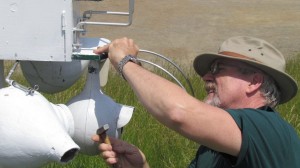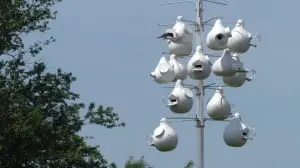Nineteen-year effort finally pays off
By Michael Turton
“Maybe being an actor makes you persistent.” That’s how local resident and actor Malachy Cleary responded when asked what kept him going during his 19-year quest to get purple martins to nest in this area. Purple martins, or Progne subis, are North America’s largest swallow — reaching a length of about 7.5 inches. Once abundant, their populations plummeted during the 20th century due to competition from invasive species such as starlings and house sparrows. Starlings are particularly aggressive and will corner a martin in its house and attack. The martin often ends up dead or at least minus its living quarters.
It’s mutual
Many people are fascinated by purple martins — largely due to their agile, high-speed aerial acrobatics. They often dive into their nests from high in the sky, flying at great speed, wings tucked in. The fact that they eat large numbers of flying insects, including mosquitoes, doesn’t hurt their popularity with Homo sapiens, either.

Martins like to be around people. In fact, they pretty much insist on it. Cleary said that they have become so domesticated that they no longer build their own nests, exclusively favoring human-made bird houses. One theory is that even before European settlement in North America, martins lived in gourds that aboriginal peoples placed on the edges of their villages. It was convenient housing for the martins, and they provided a village warning system when large predators approached. Native peoples were also no less fascinated by the birds’ acrobatic flying.
The Internet provides a glimpse into the popularity of purple martins and their distinctive houses. A quick Google search of “purple martins” yielded more than 4 million hits. “Purple martin houses” produced 45 million sites, including many commercial businesses offering houses for sale.
A boyhood interest and early failures
Cleary thanks Mrs. Lattis, his second-grade teacher in Kentucky, for piquing his interest in birds when she taught his class about the decline in the number of songbirds in North America. His first attempt at attracting purple martins came years ago at his mother-in-law’s house in Quebec’s Laurentian Mountains. Martins did come around, but they did not nest.

After his move to Philipstown, convincing purple martins to nest proved just as elusive. Cleary first tried his luck at Foundry Cove. “I thought it was a good site because it was open and near water, but there wasn’t enough human activity,” he said. Martins would show up, as they had in Quebec, but they wouldn’t stay around long enough to nest. “The adults would always go back to where they’d been the year before.” After a few attempts at the cove, he realized “it just wasn’t working.” One of the reasons it didn’t work was constant vandalism.
Success at long last
Cleary then thought of Glynwood Farm, located on Route 301 outside of Cold Spring, as a potentially good site. It features open farmland, two large ponds and quite a bit of human activity. He initially set up houses near the office, a former stable. But once again, martins appeared, showed tantalizing interest, but refused to nest. Undaunted, he moved the houses to an area between the farm’s two large barns.
The first purple martin eggs were produced in 2011. The population has been growing ever since. “This is the third year in a row with nesting birds,” Cleary said. There are now about 50 purple martins on site.
Cleary’s avian housing project
Martins prefer white houses. It is believed that the white walls provide cooler nesting sites, and the holes or cavities that give the birds access to the house can be spotted more easily against a white background.

There are three martin houses at Glynwood, each a different architectural style. One is a T-14 — a classic, tall white wooden house with 14 “apartments” plus six gourds for a total capacity of 20 birds. A smaller wooden model has 10 apartments and four gourds. The third is a “gourd rack” consisting of up to 24 gourds.
The houses sit some 17 feet atop a sturdy pole. They can be lowered, which Cleary does every four or five days in order to keep a record of the nesting activity in each house. Martins will dive at him at first but they quickly get used to his presence.
Each house entrance, numbered in a manner not unlike a high-rise apartment, leads to a small wooden box that pulls out like a drawer. Martins line the box with leaves and other materials. “Here they like to line their nest with apple leaves,” Cleary said.
On the Saturday morning that we visited, two nests contained chicks that were less than a day old.
Up to this point, Cleary has purchased his martin houses, although he’d like to build a T-14 model himself. Commercial prices vary greatly from $40 to $800.
A myth, migration and the inevitable
There is a myth surrounding purple martins. While they do eat a large number of insects — including dragonflies, moths, stink bugs, beetles and flies — Cleary said the claim that they consume up to 2,000 mosquitoes a day is bogus and was started by a manufacturer simply trying to sell his houses.

Purple martins winter in South America, favoring Brazil. They breed across the eastern half of the United States and north into the Canadian Prairie Provinces. They are also found along the Pacific coastline, including the Baja Peninsula. Last year, the Glynwood martins headed south in August. Returning adults, or “scouts,” came back in April. Younger birds or “sub-adults” showed up four to six weeks later.
The persistent Cleary never really doubted that he’d be successful — eventually. “I knew it was possible to get them to show up. And there was no reason from them not to stay.” It just took 19 years for the purple martins to figure that out.
Learn more about purple martins at the website of the Purple Martin Conservation Association, purplemartin.org.
Photos by M. Turton


What a great end to years of trying to lure the Purple Martins to Cold Spring. The Dog Squad, which used to frequent Foundry Cove, did all they could to encourage Malachy with his endeavors. All I can say is – congratulations!
Fantastic article! Thanks for the accurate, interesting read. Purple Martins depend on people for nest sites, rarely nesting anywhere except for nests put up by humans.
This is so great! Thanks Malachy for all the hard work, and thanks Michael for the terrific article. I had a pair of younger Purple Matins build a nest in a house in my backyard about six years ago, but they never returned. I want my own T-14!
Congratulations Mal! How impressive! Mrs. Lattis and our mother, Mrs. Cleary (another bird lover) would be proud of you. I am too! Mary Cleary Lewis (Malachy’s sister)
Yea, Mal. Yea, martins.
Mal Cleary is a hero for conservation and for the new science of “restoration ecology.” A hearty congratulations for this heroic work, independently accomplished without the support of a formal conservation or ornithological organization. The birders of the Hudson Valley salute you, and thanks Mike for this great article and insight into local heroes…. Pete Salmansohn, National Audubon
What a great endeavor, Malachy. Thanks for this story, P.info!